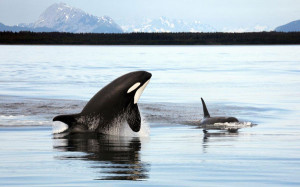“Sooty shearwater. One. Zone 2. Directional flight 20,” said Kirsten Lindquist from the bridge of the 67-foot R/V Fulmar research vessel. Lindquist was the bird observer on the first day of a five-day research cruise conducted by ACCESS, a marine research collaborative formed by PRBO Conservation Science, Cordell Bank National Marine Sanctuary, and Gulf of the Farallones National Marine Sanctuary.
On September 25, the Fulmar motored into a cold front at 10 knots along a west-to-east transect line south of the Golden Gate. A hoary sky matched the gray sea as observers in white swivel chairs called out their sightings to a recorder who entered them into the on-board computer. “One Brandt’s cormorant and one pelagic cormorant. In association. Zone 2.”
Such data can help scientists, refuge managers, and policy makers protect the marine environment and support planning of Marine Protected Areas. Recently, a consortium of scientists used observational, bathymetric (depth), and remote sensing data to study and predict seabird hotspots in the south-flowing California Current System from Canada to the US/Mexico border. The result of the study conducted by PRBO Conservation Science, NOAA Fisheries, Canadian Wildlife Service, and Hawaii Pacific University found that several of the most important hotspots in the California Current fall under the protection of Cordell Bank National Marine Sanctuary, Gulf of the Farallones National Marine Sanctuary, and the Monterey Bay National Marine Sanctuary. The scientists also discovered several hotspots in other parts of Northern California, Southern Oregon, and around the Channel Islands.
“We’re going into a well known hotspot,” said Carol Keiper, one of the observers on the recent ACCESS cruise. Below us, the continental shelf had plunged into the deep ocean, and, as if marking the change, an albatross flew by.
- Red tide seen from a research vessel off the Farallon Islands in September 2011. Photo courtesy mojoscoastphotography.com.
At the end of the transect line, the captain turned north and we rode into swells past the South, Middle, and North Farallon Islands. The scientists caught catnaps while the rest of us stayed on deck and did our best to keep our eyes on the horizon and lunch in our stomachs.
At the starting point of the second transect line, the water looked oily and brown. “Yuck,” was the scientific superlative used to describe the water pulled on deck from the trawl net. Jan Roletto, Gulf of the Farallones research coordinator, poured the water into a pre-labeled vial that would be mailed to the California Department of Public Health for testing as soon as the boat reached shore. Results wouldn’t be known for days, but Roletto and Dan Howard, superintendent of the Cordell Bank National Marine Sancturary, suspected that the red tide was Gonyaulax, a dinoflagellate that produces the potentially deadly saxitoxin. In early September, a red tide closed the Sonoma Coast to abalone fishing after a die-off of red abalone.
The west-to-east transect north of the Farallon Islands seemed almost deserted. Although the roiling surface of the sea reflected the grey, whitewashed sky, the foamy red wake behind the Fulmar told us we were still in a red tide. The reports from the observers were few. “No data is still data,” said Roletto. Neither she nor Howard would say for sure that the lack of wildlife had anything to do with the rust colored bloom, but both of them speculated that it might be the case.
The appearance of orange, dinner-plate-sized Chryosoria jellyfish–at the rate of several per second–seemed to coincide with the wake turning white again. “Mola mola!” called Keiper, as we passed a large sunfish on the changing surface of the sea that was again shimmering blue.
Learn more about wildlife hotspots in the California Current System.

.jpg)




